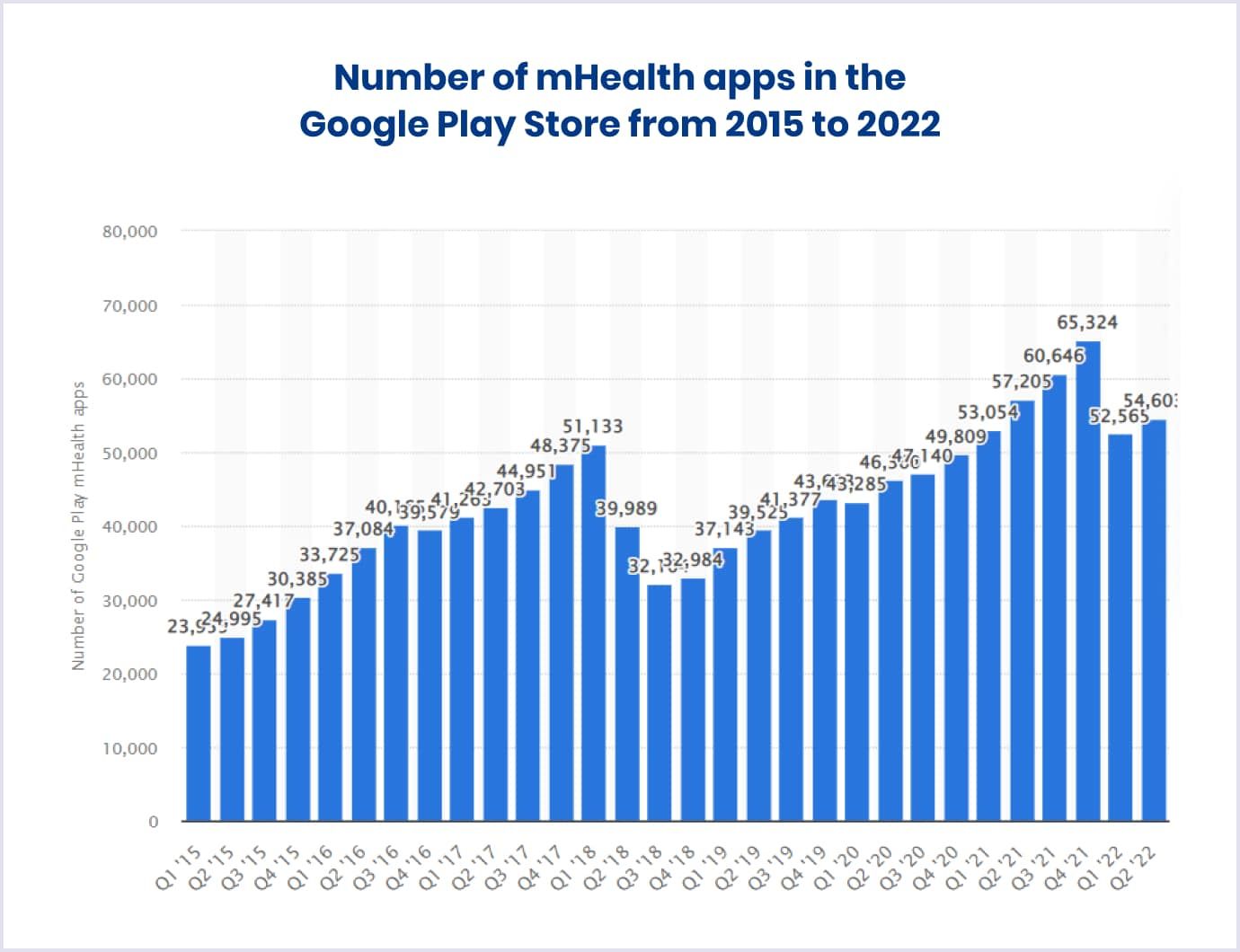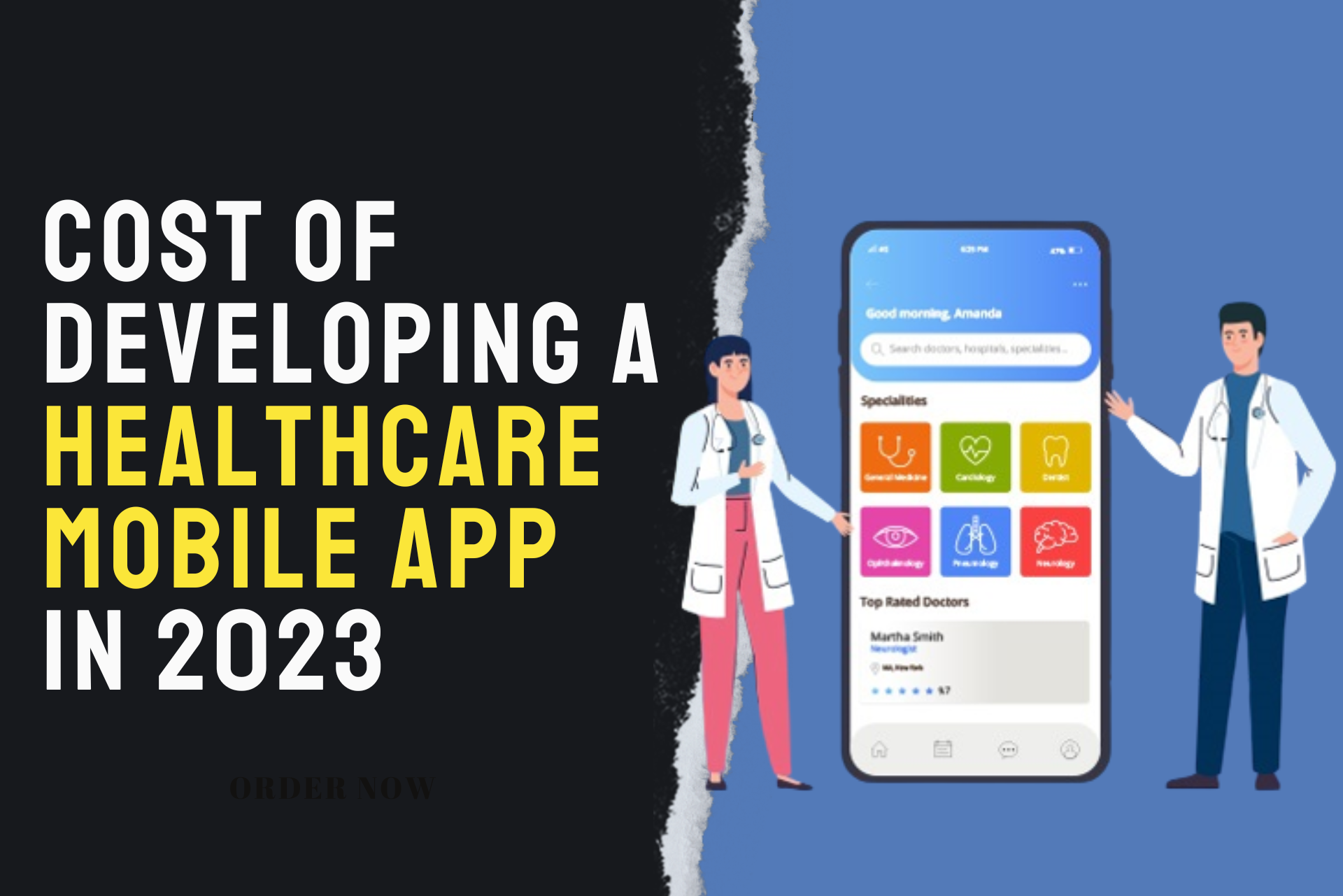Cost of Developing a Healthcare Mobile App in 2023
Importance of mobile apps in the healthcare industry
Mobile apps have become crucial in revolutionizing patient care and improving healthcare accessibility. These apps offer features like appointment scheduling, health monitoring, medication reminders, and access to medical information, empowering patients and streamlining healthcare processes.
Factors affecting the cost of healthcare app development include platform selection, complexity of features, user interface design, integration with third-party systems, security requirements, and customization needs. Other aspects like team composition, project timeline, wireframing, development stages, testing, and deployment also impact overall costs.
Notably, the mHealth app development market is projected to reach a staggering $243.57 billion by 2030, with an 18.2% growth rate.
Additionally, the global patient engagement solutions space is estimated to be valued at $32 billion by 2028. These statistics highlight the significant market potential and growing demand for healthcare app solutions.
Before we move further, you should explore the fundamentals of the process through our comprehensive guide to The Future of Healthcare Management Systems.
Factors Influencing Healthcare App Development Costs

Factors Influencing Healthcare App Development Costs
Developing a healthcare app involves various factors that impact the costs. These include choosing the platform (iOS, Android, or both), the complexity of app features, the design’s user-friendliness, integration with external systems, ensuring data security and compliance, and customizing the app for specific needs. Understanding these factors helps you plan your budget and make informed decisions during the development process.
Platform Selection (iOS, Android, or both):
Choosing the platform for your healthcare app development is important. Each platform has its own set of requirements and development processes. If you decide to target both iOS and Android, it may increase the development costs as it requires separate coding and testing for each platform.
Take a look at the statistics related to developing wellness apps:
There are 45,478 healthcare apps on the App Store of Apple.
You will find around 43,285 applications on the Play Store.

Number of mHealth apps available in the Google Play Store from 1st quarter 2015 to 3rd quarter 2022
App Complexity and Features:
The complexity and features of your healthcare app play a significant role in determining the development costs. More complex features such as appointment scheduling, health monitoring, telemedicine consultations, and data analytics may require more time and effort to develop, leading to higher costs.
User Interface and User Experience Design:
Creating an intuitive and user-friendly interface is crucial for healthcare apps. The design process involves wireframing, prototyping, and creating visually appealing interfaces. The complexity of the design and the need for a seamless user experience can impact the development costs.
Integration with Third-Party Systems and APIs:
Integrating your healthcare app with external systems, such as electronic health records (EHR) or payment gateways, can add complexity to the development process. The effort required to integrate these systems and APIs can influence the overall development costs.
Security and Compliance Requirements:
Healthcare apps deal with sensitive patient information, so ensuring data security and compliance with regulations like HIPAA is vital. Implementing robust security measures, encryption protocols, and compliance auditing can increase development costs.
Customization and Scalability Needs:
Customizing your healthcare app to meet specific requirements and scalability needs can affect the development costs. Tailoring the app to your unique workflows, branding, and scalability for future growth may require additional time and resources.
Cost Breakdown of Healthcare App Development
By understanding the cost breakdown of medical app development, stakeholders can gain insights into the various components and their associated expenses. This knowledge helps in making informed decisions, setting realistic budgets, and ensuring the successful development and deployment of a healthcare app.
Let’s study some of the key aspects of the cost breakdown of health application development.
Development Team Composition and Roles
Building a healthcare app requires a skilled and coordinated team. The development team typically consists of various roles, including project managers, software architects, developers, designers, and quality assurance specialists. Each role contributes to the app’s development, functionality, and overall success. The cost associated with the development team depends on their expertise, experience, and the duration of their involvement in the project.
Timeframe and Project Management
The timeframe of healthcare software development plays a crucial role in determining costs. A shorter timeframe may require a larger development team or dedicated resources, which can increase expenses. Efficient project management is essential to ensure smooth workflow, timely deliverables, and effective communication. Proper planning, task allocation, and project coordination help optimize costs and ensure project success.
Wireframing and Prototyping
Wireframing and prototyping are critical steps in medical software development. These processes involve creating visual representations and interactive prototypes of the app’s user interface (UI) and user experience (UX). Wireframing and prototyping help stakeholders visualize the app’s functionality and layout, identify potential improvements, and refine the overall design. The cost associated with wireframing and prototyping varies based on the complexity of the app and the level of detail required.
Backend Development and Infrastructure Setup
The backend development of a healthcare app involves building the server-side components and setting up the necessary infrastructure. This includes creating databases, implementing data storage and retrieval mechanisms, and establishing secure communication channels. The complexity and scalability requirements of the backend infrastructure impact the development cost. Additionally, the choice of technologies and frameworks can also influence expenses.
Frontend Development and UI/UX Design
Frontend development focuses on building the app’s user interface (UI) and ensuring a seamless user experience (UX). It involves translating the design into functional elements, implementing navigation, incorporating interactive features, and optimizing performance. The cost of front-end development depends on factors such as the app’s complexity, visual design requirements, and the need for responsive and user-friendly interfaces.
Testing, Quality Assurance, and Bug Fixing
Thorough testing and quality assurance are crucial to delivering a high-quality healthcare app. This involves conducting various types of testing, including functional testing, performance testing, security testing, and usability testing. Identifying and fixing bugs and issues during the development process ensures a smooth user experience and minimizes post-release complications. The cost associated with testing and quality assurance depends on the scope and depth of testing required.
App Deployment and Release
The final stages of clinical app development involve deploying the app to the desired platforms, such as app stores or enterprise distribution channels. The process includes preparing the app for submission, complying with platform-specific guidelines and regulations, and managing the release process. The cost of app deployment and release depends on factors such as the target platforms, app store fees, and any additional services required for distribution.
Average Cost Ranges for Healthcare App Development
The cost of healthcare software development can vary based on several factors. This includes the complexity of the app, with basic, moderate, and complex apps having different cost ranges. Regional cost variations also play a role, with North America, Europe, Asia, and other regions having their price dynamics. Factors such as developer rates and currency exchange rates further influence cost variations. Understanding these average cost ranges helps businesses and stakeholders in budgeting and planning their health tech app development projects effectively.
Cost ranges based on app complexity:
Basic app: Typically ranges from $10,000 to $50,000
Moderate app: Typically ranges from $50,000 to $150,000
Complex app: Typically ranges from $150,000 to $500,000 or more
Regional cost variations:
North America: Generally has higher development costs, with an average hourly rate of $100 to $200
Europe: Development costs are moderate, with an average hourly rate of $80 to $150
Asia: Offers more competitive pricing, with an average hourly rate of $30 to $80
Factors influencing cost variations:
Developer rates: Vary based on location, experience, and expertise
Currency exchange: Fluctuations in currency exchange rates can impact development costs
Additional services and features: Integration with third-party systems or complex functionalities can increase the overall cost
Understanding these factors can help businesses gain insights into the cost considerations associated with medical app development and make informed decisions regarding their project budgets and requirements.
Tips for Managing Healthcare App Development Costs
Managing the costs of healthcare app development is crucial for the success of your project. Here are some valuable tips to help you optimize your budget and ensure efficient cost management throughout the development process:
Setting clear goals and requirements:
Start by clearly defining your app’s purpose, target audience, and specific goals. Outline the essential features and functionalities you want to include.
Prioritizing essential features and functionalities:
Identify the must-have features that align with your app’s primary objectives. Focus on core functionalities first and consider adding additional features in future updates.
Regular communication with the development team:
Maintain open and frequent communication with your development team. Discuss project updates, challenges, and any changes in requirements promptly.
Agile project management approach:
Adopt an agile methodology to facilitate flexibility and iterative development. Break the project into manageable sprints and regularly review progress.
Testing and feedback iterations:
Allocate time and resources for thorough testing and quality assurance. Gather user feedback during the development process and incorporate necessary improvements.
Post-launch support and maintenance considerations:
Factor in ongoing support, bug fixing, and regular updates post-launch. Plan for future scalability and enhancements to accommodate evolving needs.
By implementing these tips, you can effectively manage your medical solution development costs while ensuring the delivery of a cost-effective and successful application.
Conclusion
In conclusion, understanding the cost of developing a healthcare mobile app in 2023 is crucial for successful project planning. We have explored various factors that influence app development costs, including platform selection, app complexity, design considerations, integration requirements, security needs, and customization demands. Additionally, we discussed the average cost ranges and provided tips for managing development costs effectively. It is important to prioritize clear goals, effective communication, and agile project management throughout the process. By partnering with experienced development teams and conducting thorough research, businesses can navigate the cost landscape and achieve their healthcare app development goals within their budget.
Every developer may not be suited for healthcare app development.
Because of this, our team of experienced developers at BharatLogic has been working on your project. We have carefully selected our healthcare mobile app development services to help you enter the market with the finest possible offering.
Our goal is to create a unique solution for your brand and customer base.
Frequently Asked Questions (FAQs)
Q1: What factors influence the cost of developing a healthcare mobile app?
A1: The cost is influenced by factors such as app complexity, desired features, platform selection, design requirements, integration needs, security considerations, and customization demands.
Q2: How much does it cost to develop a basic healthcare app?
A2: The cost can vary, but a basic healthcare app typically falls within the range of $10,000 to $50,000, depending on the specific requirements and complexity.
Q3: Are there regional cost variations in healthcare app development?
A3: Yes, the cost can vary based on the region. North America and Europe generally have higher development rates compared to regions like Asia or Eastern Europe.
Q4: How can I manage healthcare app development costs effectively?
A4: To manage costs effectively, set clear goals and requirements, prioritize essential features, maintain regular communication with the development team, follow an agile project management approach, conduct testing and feedback iterations, and consider post-launch support and maintenance needs.
Q5: Is it important to collaborate with an experienced development partner?
A5: Yes, partnering with an experienced development team can provide valuable expertise and guidance, ensuring efficient cost planning, quality development, and timely delivery of the healthcare app.

